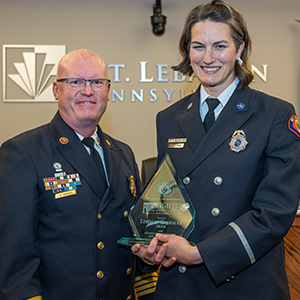commission eyes options on public works yard
On March 11, the Mt. Lebanon Commission heard a presentation from RSSC Architecture on possible plans for renovations to the public work facility on Lindendale Drive. The preliminary report presented a broad range of ideas for the parcel of land, which includes a salt storage building, a fuel point for municipal vehicles, a vehicle maintenance garage, garage bays for public works vehicles, parking for police and fire department trailers and storage areas for public works equipment. The complex is also home to the police department firing range. The plan summarized the results of a yearlong study the firm was commissioned to do on a public works master plan.
The Commission approved a professional service contract with RSSC Architecture in 2013 to evaluate the current public works facilities along Cedar Boulevard and to prepare a master plan to meet current and future needs of public works operations. The consultants responded to a Request for Proposals (RFP) prepared by the municipal engineer with input from the commission and public works director. The main brick facility was constructed in the 1950s and other pole buildings were built in the 1970s.
The preliminary plan was broken into two concepts for the overall site plan and gave multiple options for each floor of the buildings.
As part of the research, RSSC interviewed public works employees who worked at the site, who agreed that the most important issue to resolve was one of employee safety, as the long street of the complex, from the Lindendale Drive entrance, has no speed barriers, and employees report that contractors entering the site to make deliveries drive the length of the facility at unsafe speeds. Vehicles exiting the maintenance and parking garages risk collision with contractors’ vehicles.
Both site plan concepts proposed to remedy the situation by relocating the salt storage building from its present place against the hillside to a spot in the center of the road, about half the length of the unbarricaded street creating other barriers at the entrance to the yard.
Other factors under consideration are covered storage for public works equipment, increased garage space for vehicles, and developing the southern third of the public works compound into a small park or nature center. That plot of land was purchased with money from the Pennsylvania Department of Conservation and Natural Resources with the stipulation that it be used for recreation.

Cost estimates for everything at the public works yard is $5,461,200 for building construction, $1,712,700 for site improvements, and $1,420,000 for soft costs and contingencies, for a total of $8,593,900, but commissioners emphasized that cost was for everything in the project, a scenario that was highly unlikely to come to fruition.
The consultants were purposely not given a budget limit, says Commissioner David Brumfield, because the aim was to provide the commission with a range of options, not to complete a specific project within a specific limit.
“That was part of our developing the plan,” he says. “We specifically didn’t give a budget. We were going to get the recommendation back and determine, based on what we could afford, what was the best option. This is just the first step. This is just saying ‘here’s perfection. Maybe it’s too expensive, but here is your best solution and if we decide we have to scale back for cost then that’s what we have to do.’ But I think this is the discussion we were intending to have.”
Municipal manager Steve Feller likened the preliminary public works plan to the master plan completed for the Mt. Lebanon park system in 2004. “That plan ran to millions of dollars,” he says. “We didn’t do everything that was contained in the plan.”
“I don’t see how we could have had this discussion on budget before we had ideas like this (presented),” Brumfield said. “Part of what we selected this company for was to focus on identifying program needs, taking that information to the next step of, what’s the setup that maximizes that? So now we have the option of hearing ‘OK, if you don’t take the top choice, it’s going to hurt your program, but this is what you save.’ We know what we’re giving up in exchange for the dollars.”
Discussion on narrowing the scope of the plan is expected to continue for several months, leading up to the drafting of the capital improvement plan and the 2015 budget.





